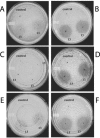SST2, a regulator of G-protein signaling for the Candida albicans mating response pathway
- PMID: 16400182
- PMCID: PMC1360253
- DOI: 10.1128/EC.5.1.192-202.2006
SST2, a regulator of G-protein signaling for the Candida albicans mating response pathway
Abstract
Candida albicans contains a functional mating response pathway that is similar to the well-studied system of Saccharomyces cerevisiae. We have characterized a regulator of G protein signaling (RGS) homolog in C. albicans with sequence similarity to the SST2 gene of Saccharomyces cerevisiae. Disruption of this gene, which had been designated SST2, causes an opaque MTLa/MTLa derivative of strain SC5314 to show hypersensitivity to the C. albicans alpha-factor. This hypersensitivity generates an enhanced cell cycle arrest detected in halo assays but reduces the overall mating efficiency of the cells. Transcriptional profiling of the pheromone-regulated gene expression in the sst2 mutant shows a pattern of gene induction similar to that observed in wild-type cells, but the responsiveness is heightened. This involvement of an RGS in the sensitivity to pheromone is consistent with the prediction that the mating response pathway in C. albicans requires the activation of a heterotrimeric G protein.
Figures






Similar articles
-
Barrier activity in Candida albicans mediates pheromone degradation and promotes mating.Eukaryot Cell. 2007 Jun;6(6):907-18. doi: 10.1128/EC.00090-07. Epub 2007 Apr 6. Eukaryot Cell. 2007. PMID: 17416895 Free PMC article.
-
Heterotrimeric G-protein subunit function in Candida albicans: both the alpha and beta subunits of the pheromone response G protein are required for mating.Eukaryot Cell. 2008 Sep;7(9):1591-9. doi: 10.1128/EC.00077-08. Epub 2008 Jul 25. Eukaryot Cell. 2008. PMID: 18658257 Free PMC article.
-
Genome-scale analysis reveals Sst2 as the principal regulator of mating pheromone signaling in the yeast Saccharomyces cerevisiae.Eukaryot Cell. 2006 Feb;5(2):330-46. doi: 10.1128/EC.5.2.330-346.2006. Eukaryot Cell. 2006. PMID: 16467474 Free PMC article.
-
Mating in Candida albicans and the search for a sexual cycle.Annu Rev Microbiol. 2005;59:233-55. doi: 10.1146/annurev.micro.59.030804.121310. Annu Rev Microbiol. 2005. PMID: 15910278 Review.
-
Characterizations and functions of regulator of G protein signaling (RGS) in fungi.Appl Microbiol Biotechnol. 2013 Sep;97(18):7977-87. doi: 10.1007/s00253-013-5133-1. Epub 2013 Aug 6. Appl Microbiol Biotechnol. 2013. PMID: 23917634 Review.
Cited by
-
Widespread occurrence of chromosomal aneuploidy following the routine production of Candida albicans mutants.FEMS Yeast Res. 2009 Oct;9(7):1070-7. doi: 10.1111/j.1567-1364.2009.00563.x. Epub 2009 Aug 6. FEMS Yeast Res. 2009. PMID: 19732157 Free PMC article.
-
Genes selectively up-regulated by pheromone in white cells are involved in biofilm formation in Candida albicans.PLoS Pathog. 2009 Oct;5(10):e1000601. doi: 10.1371/journal.ppat.1000601. Epub 2009 Oct 2. PLoS Pathog. 2009. PMID: 19798425 Free PMC article.
-
Evolution of mating within the Candida parapsilosis species group.Eukaryot Cell. 2011 Apr;10(4):578-87. doi: 10.1128/EC.00276-10. Epub 2011 Feb 18. Eukaryot Cell. 2011. PMID: 21335529 Free PMC article.
-
Candida albicans cell wall proteins.Microbiol Mol Biol Rev. 2008 Sep;72(3):495-544. doi: 10.1128/MMBR.00032-07. Microbiol Mol Biol Rev. 2008. PMID: 18772287 Free PMC article. Review.
-
Structure-Activity Relationship of α Mating Pheromone from the Fungal Pathogen Fusarium oxysporum.J Biol Chem. 2017 Mar 3;292(9):3591-3602. doi: 10.1074/jbc.M116.766311. Epub 2017 Jan 18. J Biol Chem. 2017. PMID: 28100777 Free PMC article.
References
-
- Bernards, A., and J. Settleman. 2004. GAP control: regulating the regulators of small GTPases. Trends Cell Biol. 14:377-385. - PubMed
-
- Cabrera-Vera, T. M., J. Vanhauwe, T. O. Thomas, M. Medkova, A. Preininger, M. R. Mazzoni, and H. E. Hamm. 2003. Insights into G protein structure, function, and regulation. Endocr. Rev. 24:765-781. - PubMed
Publication types
MeSH terms
Substances
LinkOut - more resources
Full Text Sources
Molecular Biology Databases

